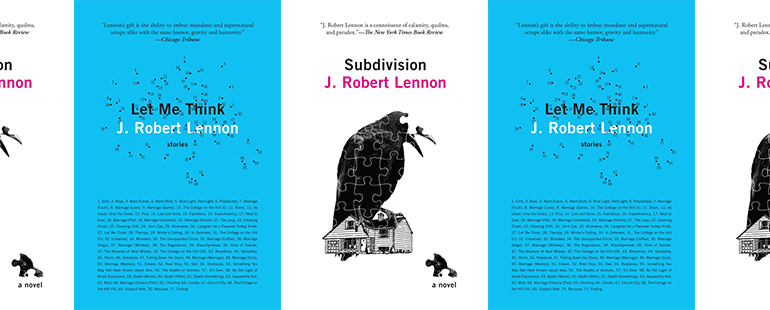“These two books, taken together, offer a nice survey of my anxieties and preoccupations over the past decade”: An Interview with J. Robert Lennon

J. Robert Lennon’s dual release, last week, of the novel Subdivision (his ninth) and the short story collection Let Me Think (his third) highlight Lennon’s ability to create literature that is surreal yet accessible, poignant yet eerie. Subdivision is a novel willing to shift its own shape on a whim, and its mysterious and magical moments are seen in compressed form in the pieces of Let Me Think, where the more mundane aspects of life are used to expose existential angst. Each book offers up an aesthetic of the uncompromising, the surprising, and the fantastic, either cloaked in the everyday or surreally spread.
At its onset, Let Me Think has the sense of a more “regular” life than Subdivision. Its seventy-one stories, many only a page or two in length, deal with typical aspects of living—meals, money, relationships; doing the dishes; going on vacation—but what keeps the pieces so engaging is each story’s underlying oddity. In some, authorial constraints create the peculiarities, like in “#facultyretreat,” which is written under the 260-character restraint of a Twitter feed. Another piece, “Subject Verb,” is composed entirely of two-word subject-verb sentences. And in the story “Because,” each sentence begins, as you may have guessed, with the word “because.” These constraints shake up the collection.
Let Me Think similarly offers oddities in the way in which its mundane situations are burst—characters react and interact in refreshingly unique ways, and many endings pivoting into larger existential conclusions. There is a string of stories mixed throughout the collection, for instance, in which all share the same characters, who are put into ever-evolving situations. “Marriage (Love),” “Marriage (Sick),” “Marriage (Pie),” and the other “Marriage” pieces don’t share a straight-forward storyline, but they put the same characters in various moments of love and separation, of fault and forgiveness, forging a larger commentary on marriage as an institution and on the often comically (and sometimes sad) shifting sands of relationships.
Subdivision takes this use of oddities further, creating a deluge of the surreal. We don’t know what has brought the main character to stay in a guesthouse in a place called “The Subdivision”; we only know that she is looking for a job and a permanent place to live, and that in the guesthouse there is a puzzle on the downstairs table: “It occupied the entire surface of a massive wooden dining table that nearly filled the room it inhabited,” she says. “The pieces were extremely small, and very few of them appeared to bear distinctive pattern or color, instead betraying only the faintest gradations between bluish-white and whitish-gray.” An extension of the puzzle itself, everything around the narrator is mired in suspicion and mystery; her world is filled with unraveling relationships.
Characters in Subdivision appear and disappear. Some turn out to be amnesic. One is a bakemono-style shape-shifter intent on bedding the narrator, and one is a child that most assume is hers, though she’s never met him. The landscape, too, is enigmatic, with some of the houses in “The Subdivisions” enchanted, others haunted, and several locations forbidden or unmapped or invisible. A crow follows our heroine around town, and she’s guided by a pocket-sized, digital device known as Cylvia, a small gray cylinder who offers advice and warnings, and who begins to take on more apparent human characteristics as the novel progresses.
The Subdivision grows ever more complicated and puzzling until the novel’s conclusion; even in the end, the protagonist’s backstory is still mostly missing, the context of “The Subdivision” is never fully revealed, and the journey remains bathed in wonderfully sticky absurdities and strange charms. But as with the stories in Let Me Think, Lennon provides a scaffolding for the audience—objects like the puzzle help ground the novel even amidst its surreal intricacies. No matter how bizarre Subdivision might trend, there is always a known entity that lets us find our footing, and that is the magic of Lennon’s work.
J.A. Tyler:Let Me Think is composed largely of flash fiction. What draws you to brevity in your short story writing?
J. Robert Lennon:I first started writing short things when I had a small child, and the child would take naps, and I wanted to do something other than sit around waiting anxiously for her to wake up. I’d been reading a few short-short story writers a lot, like Lydia Davis, Thomas Bernhard, and Donald Barthleme, and they influenced what I ended up with, which was [the 2005 collection] Pieces for the Left Hand.In this book, I tried to do something new every time I went back to short shorts; it has become a long-term proving ground for various ideas and forms.
JAT: In terms of a proving ground, how have these ideas or forms in your short stories gone on to shape your novels?
JRL: Sometimes I get attached to the aesthetic or characters of a story and want to stay inside it. My [2003] novel Mailman was originally a short story, as was the novel I’m trying to write now. But most formal influences are less explicit than that. It’s more like, Aha, that kind of sentence is a thing I can do, that style of voice, that narrative technique. What ends up in the novels is usually altered beyond recognition by the demands of the specific work, but it’s all in there.
JAT: Several stories in the collection are connected by way of their titles. For instance, there are twelve individual pieces titled “Marriage” with parentheticals—“(Fault),” “(Love),” “(Pie),” “(Whiskey),” “(Sick),” and others. Did you write these as a series, or did they develop organically, over time, each on their own?
JRL: A few of these little series were the result of an exercise I was doing with a student of mine, Shakarean Hutchinson. I assigned us both these little triptychs that had to be composed all on the same page. But the “Marriage” ones were serendipitous. I wrote one as a standalone short and found the characters so funny that I kept finding new shapes for their disharmony to take. I started a novel about them trying to have a baby, but I’m not sure if they really belong in a novel. We’ll see. They definitely shouldn’t have a baby.
JAT: Like the “Marriage” stories, there are multiple “The Cottage on the Hill” pieces, which are dispersed throughout the collection, though the storyline and characters clearly carry and progress through the whole set. Was this piece written as a larger story and then disconnected, or was it built and always intended to be read as separates?
JRL: That one is the most revised in the book. It was originally published as one story, but I liked it better broken up and scattered around. The various pieces correspond to different thematic arcs in the book, so it seemed a natural thing to do. The story was inspired by an episodic dream I had one night while traveling—a rare occurrence, I don’t think I’ve written any other stories based on dreams.
JAT: Constraints are a part of a handful of pieces too, most notably “#facultyretreat,” “Subject Verb,” and “Because.” I suppose it is a little chicken/egg, but did the constraint create the piece, or did the piece require the constraint?
JRL: These all came from the constraints! When I wrote “#facultyretreat” I was literally participating in, or I guess not participating in, a faculty retreat for my academic department, and was issuing those little fragments live during the meeting, onto a short-lived social media platform called App Dot Net. Nobody saw them, I don’t think. “Subject Verb” came from an assignment I gave to a class that had a few overwriters in it; I wanted them to see how little of their style came from adornment, and how much of it came from the pattern of their thinking. And “Because” was part of a project I did where I composed stories on my phone, in the text messaging app, and then texted them to random contacts without explanation. Originally I posted them on a Tumblr as screenshots that also included the recipients’ puzzled replies.
JAT: You said that you don’t think you’ve written any other stories based on dreams, but much of Subdivision feels like a dream or at least a dreamscape. If it wasn’t a dream, what was the seed of this novel?
JRL: The logic of the novel is deliberately dreamlike, but the inspiration came from a bed and breakfast I stayed in a few years ago. The proprietors told me to come downstairs anytime to work on a giant puzzle in the front room. I told a friend about this and they said it sounded like the opening of a novel. I laughed at first; solving the puzzle could be a hilariously obvious metaphor for unlocking a psychological mystery. But I wrote a few pages anyway and they immediately felt like a dream—maybe because metaphors in dreams are often obvious, but only after you wake up. So the character’s obliviousness inside the story became a part of its internal logic. The reader, outside the dream, can eventually see what’s going on, but the protagonist cannot.
JAT: We aren’t given much in terms of the protagonist’s context or backstory. What was the intention for approaching the novel in this way?
JRL: What little I include of the protagonist’s past is a deliberate mystery, at least for the first half of the book. But ultimately I’m not a big fan of backstory, at least not the kind that explains a character’s behavior. The worst novel ending perhaps ever is that of Ian McEwan’s otherwise great Enduring Love, which takes the form of a medical report clinically diagnosing the antagonist. All the glorious strangeness of what you just read is pedantically snatched away from you.
JAT: The bakemono you include is a creature from Japanese folklore, one linked to transformation; in Subdivision, the bakemono plays a fair-sized role. Where did the inclusion of this creature come from?
JRL: I’m sure a folklorist would recognize that I’m taking some liberties with my portrayal of this supernatural creature. Part of the shtick of this novel is that its dreamlike world has metastasized around half-remembered things from its protagonist’s life, so that they appear distorted, not-quite-correct. The bakemono is one of those things—others are the nonexistent types of batter[ies], the extra “Happy Birthday” verses, and so on. I wanted the details to make the reader think, Wait, that can’t be right.
JAT: Has releasing a story collection and a novel at the same time proffered any otherwise unseen connections between the two books, links you might not have noticed had they been released separately?
JRL: These two books, taken together, offer a nice survey of my anxieties and preoccupations over the past decade . . . they’re quite the tour of my subconscious. Not sure if that’s a selling point or not.


